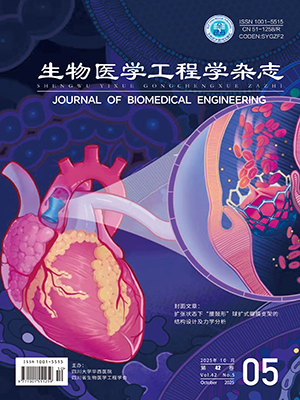| 1. |
WHITE A, BRODER J, MANDO-VANDRICK J, et al. Acute aortic emergencies-part 2: aortic dissections[J]. Adv Emerg Nurs J, 2013, 35(1): 28-52.
|
| 2. |
BEAN M J, JOHNSON P T, ROSEBOROUGH G S, et al. Thoracic aortic stent-grafts: utility of multidetector CT for Pre- and postprocedure evaluation[J]. Radiographics, 2008, 28(7): 1835-1851.
|
| 3. |
SHIRALI A S, BISCHOFF M S, LIN H M, et al. Predicting the risk for acute type B aortic dissection in hypertensive patients using anatomic variables[J]. JACC Cardiovasc Imaging, 2013, 6(3): 349-357.
|
| 4. |
NIENABER C A. Aortic dissection[J]. Dtsch Med Wochenschr, 2012, 137(45): 2323-2326.
|
| 5. |
HARRIS K M, BRAVERMAN A C, EAGLE K A, et al. Acute aortic intramural hematoma: an analysis from the international registry of acute aortic dissection[J]. Circulation, 2012, 126(11 Suppl 1): S91-S96.
|
| 6. |
LOEBE M, REN D, RODRIGUEZ L, et al. Acute and chronic thoracic aortic disease: surgical considerations[J]. HSR Proc Intensive Care Cardiovasc Anesth, 2012, 4(4): 243-250.
|
| 7. |
HUGHES G C, ANDERSEN N D, MCCANN R L. Management of acute type B aortic dissection[J]. J Thorac Cardiovasc Surg, 2013, 145(3 Suppl): S202-S207.
|
| 8. |
KÖLBEL T, DIENER H, LARENA-AVELLANEDA A, et al. Advanced endovascular techniques for thoracic and abdominal aortic dissections[J]. J Cardiovasc Surg (Torino), 2013, 54(1 Suppl 1): 81-90.
|
| 9. |
NIENABER C A, ROUSSEAU H, EGGEBRECHT H, et al. Randomized comparison of strategies for type B aortic dissection: the investigation of stent grafts in aortic dissection (instead) trial[J]. Circulation, 2009, 120(25): 2519-2528.
|
| 10. |
MIDULLA M, FATTORI R, BEREGI J P, et al. Aortic dissection and malperfusion syndrome: a when, what and how-to guide[J]. Radiol Med, 2013, 118(1): 74-88.
|
| 11. |
JIA X, GUO W, LI T X, et al. The results of stent graft versus medication therapy for chronic type B dissection[J]. J Vasc Surg, 2013, 57(2): 406-414.
|
| 12. |
WHITE G H, YU W, MAY J, et al. Endoleak as a complication of endoluminal grafting of abdominal aortic aneurysms: classification, incidence, diagnosis, and management[J]. J Endovasc Surg, 1997, 4(2): 152-168.
|
| 13. |
SUNDER-PLASSMANN L, OREND K H. Stentgrafting of the thoracic aorta-complications[J]. J Cardiovasc Surg (Torino), 2005, 46(2): 121-130.
|
| 14. |
YANG C P, HSU C P, CHEN W Y, et al. Aortic remodeling after endovascular repair with stainless steel-based stent graft in acute and chronic type B aortic dissection[J]. J Vasc Surg, 2012, 55(6): 1600-1610.
|
| 15. |
WILLIAMS D M, LEE D Y, HAMILTON B H, et al. The dissected aorta: part Ⅲ. Anatomy and radiologic diagnosis of branch-vessel compromise[J]. Radiology, 1997, 203(1): 37-44.
|
| 16. |
QIN Y L, DENG G, LI T X, et al. Risk factors of incomplete thrombosis in the false lumen after endovascular treatment of extensive acute type B aortic dissection[J]. J Vasc Surg, 2012, 56(5): 1232-1238.
|
| 17. |
GORLITZER M, WEISS G, MOIDL R, et al. Repair of stent graft-induced retrograde type A aortic dissection using the E-vita open prosthesis[J]. Eur J Cardiothorac Surg, 2012, 42(3): 566-570.
|
| 18. |
MAMOPOULOS A T, NOWAK T, LUTHER B. Retrograde ascending Stanford B aortic dissection complicating a routine infrarenal endovascular aortic reconstruction[J]. J Vasc Surg, 2013, 58(1): 208-211.
|
| 19. |
SHU C, WANG T, LI Q M, et al. Thoracic endovascular aortic repair for retrograde type A aortic dissection with an entry tear in the descending aorta[J]. J Vasc Interv Radiol, 2012, 23(4): 453-460.
|
| 20. |
CHOI C H, PARK C H, JEON Y B, et al. Early and mid-term changes of the distal aorta after total arch replacement for acute type A aortic dissection[J]. Korean J Thorac Cardiovasc Surg, 2013, 46(1): 33-40.
|
| 21. |
COCHENNEC F, TRESSON P, CROSS J, et al. Hybrid repair of aortic arch dissections[J]. J Vasc Surg, 2013, 57(6): 1560-1567.
|
| 22. |
CHANG Q, TIAN C, WEI Y, et al. Hybrid total arch repair without deep hypothermic circulatory arrest for acute type A aortic dissection(R1)[J]. J Thorac Cardiovasc Surg, 2013, 146(6): 1393-1398.
|
| 23. |
ZHAO H P, ZHU J M, MA W G, et al. Total arch replacement with stented elephant trunk technique for acute type B aortic dissection involving the aortic arch[J]. Ann Thorac Surg, 2012, 93(5): 1517-1522.
|
| 24. |
TSAI H C, CHEN I M, HSIEH Y C, et al. Concomitant Bentall operation plus aortic arch replacement surgery[J]. J Chin Med Assoc, 2013, 76(2): 88-94.
|
| 25. |
KITAMURA T, KIGAWA I, FUKUDA S, et al. Long term results with the Cabrol aortic root replacement[J]. Int Heart J, 2011, 52(4): 229-232.
|
| 26. |
HOLLOWAY B J, ROSEWARNE D, JONES R G. Imaging of thoracic aortic disease[J]. Br J Radiol, 2011, 84(3): S338-S354.
|
| 27. |
HABETS J, ZANDVOORT H J, REITSMA J B, et al. Magnetic resonance imaging is more sensitive than computed tomography angiography for the detection of endoleaks after endovascular abdominal aortic aneurysm repair:a systematic review[J]. Eur J Vasc Endovasc Surg, 2013, 45(4): 340-350.
|




